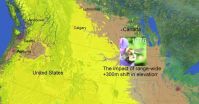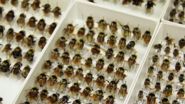Climate change impacts on bumblebees converge across continents
2015-07-09
(Press-News.org) This news release is available in Japanese.
While the geographic ranges of many animals are expanding northward in response to climate change, those of North American and European bumblebee species are shrinking, a new study shows. These insects are failing to migrate northward, the study reveals, and in their southern territories, their ranges are compressing -- with range losses up to 300 kilometers in both North America and Europe. The findings reveal the vulnerability of these pollinators, which play key roles in agriculture, to a warming world, hinting that they may experience more rapid climate-related decline than other species. In response to changes in warmer temperatures, many animal species have shifted their geographical ranges northward. To investigate whether bumblebees' responses to climate change have followed suit, Jeremy Kerr and colleagues generated a database of geotagged observations of 67 European and North American bumblebee species from 1901 to 2010. They compared changes in individual bee species' northward movements in recent decades, against baseline bumblebee activity from 1901 to 1974, when the climate was cooler. To their surprise, bumblebees in recent, warmer decades didn't shift their ranges north. Simultaneously, their populations disappeared from the southernmost and hottest parts of their ranges. The researchers evaluated the roles of factors besides climate change, like land use and pesticide application, in causing range losses in the southern regions -- finding no significant correlation. Figuring out why bumblebees are not shifting their ranges northward like many other terrestrial animals will require further evaluation, the researchers say. Their results reveal the importance of studying vulnerability to climate change at both extremes of a species' geographic range.
INFORMATION:
Article #12: "Climate change impacts on bumblebees converge across continents," by J.T. Kerr at University of Ottawa in Ottawa, ON, Canada, and colleagues. For a complete list of authors, see the manuscript.
ELSE PRESS RELEASES FROM THIS DATE:
2015-07-09
This news release is available in Japanese.
Researchers have designed a more efficient jumping robot with three-dimensional (3D) printing techniques and a combination of hard and soft materials. Inspired by designs in nature, such as snakes or insect larvae, soft-bodied robots are safer, more adaptable, and more resilient than their traditionally rigid counterparts, but molding and powering them has proved challenging. Now, Nicholas Bartlett and colleagues report a technique for designing and manufacturing untethered, frog-like jumping machines with ...
2015-07-09
Traditional industrial robots are rigid -- mostly metal -- and are fast, precise and powerful. Their speed and precision comes at the cost of complexity and can often pose a danger to humans who get too close. Soft robots are adaptable and resilient but slow, difficult to fabricate, and challenging to make autonomous because most motors, pumps, batteries, sensors, and microcontrollers are rigid.
But what if you could combine the autonomy and speed of a rigid robot with the adaptability and resiliency of a soft robot -- and do it relatively cheap and fast?
Harvard engineers ...
2015-07-09
Monterey, CA - Thousands of feet below the ocean's surface lies a hidden world of undiscovered species and unique seabed habitats--as well as a vast untapped store of natural resources including valuable metals and rare-earth minerals. Technology and infrastructure development worldwide is dramatically increasing demand for these resources, which are key components in everything from cars and modern buildings to computers and smartphones. This demand has catalyzed interest in mining huge areas of the deep-sea floor.
In a paper published this week in Science, researchers ...
2015-07-09
Engineers at Harvard University and the University of California, San Diego, have created the first robot with a 3D-printed body that transitions from a rigid core to a soft exterior. The robot is capable of more than 30 untethered jumps and is powered by a mix of butane and oxygen. Researchers describe the robot's design, manufacturing and testing in the July 10 issue of Science magazine.
"We believe that bringing together soft and rigid materials will help create a new generation of fast, agile robots that are more robust and adaptable than their predecessors and can ...
2015-07-09
New York, 9 July - Investing up to 3.5% of a nation's GDP in science, technology and innovation - including basic science and education - is a key benchmark for advancing sustainable development effectively, leading experts say.
In papers released July 9 in New York, international scientists advising UN Secretary-General Ban Ki-moon say closing the gap between developed and developing countries depends on first closing international science, technology and innovation (STI) investment gaps.
According to the UN SG's 26-member Scientific Advisory Board: "While a target ...
2015-07-09
Black holes can be found at the centres of most galaxies. Most have little mass compared with their host galaxy. ETH researchers, however, have discovered a particularly massive black hole, which clearly grew so quickly that the host galaxy was not able to keep pace. This calls into question previous thinking on the co-evolution of galaxies and their central black holes.
Benny Trakhtenbrot, a researcher at ETH Zurich's Institute for Astronomy, together with an international team of astrophysicists, was hunting for ancient massive black holes using the 10 meter Keck telescope ...
2015-07-09
Many areas of fundamental research are interested in graphene owing to its exceptional characteristics. It is made of one layer of carbon atoms, which makes it light and sturdy, and it is an excellent thermal and electrical conductor. Despite its apparently limitless potential, however, few applications have been demonstrated to date. Scientists at EPFL's Bionanophotonic Systems Laboratory (BIOS) together with researchers from the Institute of Photonic Sciences (ICFO, Spain) have now added another one. They have harnessed graphene's unique optical and electronic properties ...
2015-07-09
CORVALLIS, Ore. - A new review analyzing three decades of research on the historic effects of melting polar ice sheets found that global sea levels have risen at least six meters, or about 20 feet, above present levels on multiple occasions over the past three million years.
What is most concerning, scientists say, is that amount of melting was caused by an increase of only 1-2 degrees (Celsius) in global mean temperatures.
Results of the study are being published this week in the journal Science.
"Studies have shown that both the Greenland and Antarctic ice sheets ...
2015-07-09
Scientists at the University of East Anglia, University of Barcelona, University Pompeu Fabra and several other European institutions have found a way to separate the medical benefits of cannabis from some of its unwanted side effects.
The research comes from the team that had previously discovered how the main psychoactive ingredient in cannabis, known as tetrahydrocannabinol or THC, reduces tumour growth in cancer patients.
Their latest findings, publishing on July 9th in the Open Access journal PLOS Biology, reveal how some detrimental cognitive effects of THC are ...
2015-07-09
Many animals actively touch objects in their environment and respond to them by appropriate movement sequences. Jan Ache and Volker Dürr from Bielefeld University in Germany present a model in PLOS Computational Biology that captures key properties of a wide variety of descending neurons that are part of an "active touch system".
Goal-directed actions require neurons that descend from the brain to lower parts of the nervous system, for example: to distribute sensory information to local modules of movement control. Stick insects actively explore the near-range environment ...
LAST 30 PRESS RELEASES:
[Press-News.org] Climate change impacts on bumblebees converge across continents







